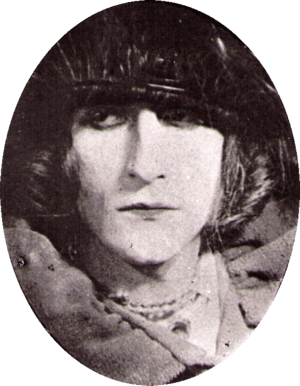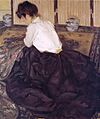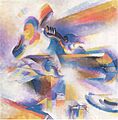American modernism facts for kids
American modernism is a big artistic and cultural movement in the United States. It started around the early 1900s and was strongest between World War I and World War II. Think of it like a new way of thinking and creating art that came from huge changes happening in the world.
Just like the wider modernism movement, American modernism was a fresh start. It moved away from older ideas from the Age of Enlightenment. Artists and thinkers wanted to show reality in a new way, especially in a world that was becoming more industrial and modern.
Contents
What is American Modernism?
Modernist art often looks a bit abstract and is very creative. It's about new ideas, beauty, and even looking to the future. This movement included many types of art like painting, literature, music, movies, design, and architecture. It even changed how people lived their lives!
Modernism pushed back against old art rules and traditions. The idea was that art shouldn't just be in fancy academies or concert halls. Instead, it should be part of everyday life and something everyone could enjoy.
During the 1920s, called the Roaring Twenties, the U.S. saw lots of economic and technological growth. This made some people feel very hopeful about the future, and this hope influenced some modernist artists. Others were a bit more careful about how much technology was taking over.
After winning World War I, the U.S. became a major player on the world stage. This gave Americans a lot of confidence. In this exciting time, American modernism began to create art that was truly American, not just copying European styles anymore.
How Did Modernism Grow in America?
American modernism became rich and diverse because of all the different immigrant cultures. Artists found inspiration in African, Caribbean, Asian, and European folk art. They wove these unique styles into their own creations.
The movement really showed what American life was like in the 20th century. With fast industrial growth, it was easy for individuals to feel lost or without purpose. Old social rules about race, class, gender, wealth, and religion were being questioned. As these old ways broke down, some people felt a loss of identity, leading to feelings of being alone or separate. The unity felt during the war started to fade.
Many middle-class workers felt like small, unimportant parts of a huge machine. Young people's dreams sometimes shattered with disappointment. The lives of those who felt lost or like outsiders became more important in art. Being able to define yourself through hard work and creativity, without relying on old traditions, became highly valued. Some artists celebrated this, while others, like F. Scott Fitzgerald, explored how tempting but ultimately harmful privilege could be.
Modernist America had to find new common ground when old beliefs were no longer shared. This common ground was found in the shared experiences of all humans. The importance of each person was highlighted. The idea that everyone's experience is limited, no matter their background, created a bond across all differences. In this way, society found meaning even in confusing times.
Some people saw modernism as a continuation of 19th-century ideas about "art for art's sake" (art just for beauty). Others, like art critic Clement Greenberg, believed modernist art focused only on itself. But many saw modernist art, especially in blues and jazz music, as a way to express feelings. Many works also dealt with current issues like feminism and city life. Some artists even added political messages to American modernism.
Modernist design and architecture helped people live modern lives. Work and family life changed quickly in the 1920s. Cars became popular and affordable, leisure time became more important, and women found more job opportunities. Designers and architects aimed to make daily life more efficient, especially housework.
The Great Depression in the late 1920s and 1930s made people doubt the country's economic stability. This ended much of the hopeful, utopian thinking. The horrors of World War II caused even more changes in how people thought. The time after the war was called Late Modernism. Later, starting around the 1980s, the Postmodernist era began.
Visual Arts in American Modernism
American Modernist Painting
There isn't one exact date when modern art began in America. Many painters were active in the early 1900s. This was when the first cubist landscapes, still-life paintings, and portraits appeared. Bright colors became popular, and the first non-objective (not showing real objects) paintings were shown.
The modernist movement grew in New York City by 1913. The famous Armory Show in New York City in 1913 showed art by both European and American artists. Paintings in styles like Impressionism, Fauvism, and Cubism surprised many Americans who were used to more traditional art. But many American artists were inspired by these new and radical ideas.
The early 20th century was a time of exploring different art techniques. Many American artists like Wilhelmina Weber Furlong, Man Ray, and Patrick Henry Bruce traveled to Europe, especially Paris, to create art. Different art groups formed, leading to many different meanings in visual arts.
- The Ashcan School focused on realism, showing everyday life in cities.
- The Stieglitz group created abstract visions of New York City.
- Color painters developed colorful, abstract "synchromies."
- Precisionism showed the industrial landscape of America with sharp, geometric shapes.
Artists like Georgia O'Keeffe, often called the "Mother of American Modernism," helped bring modernism to the New York School.
The focus in visual arts also shifted to many different subjects. For example, the group called The Eight focused on the modern city and its diverse people. Artists like Robert Henri and John French Sloan painted about social diversity, often showing people living in city slums.
In the late 1920s and 1930s, two important movements were Regionalism and Social Realism.
- Regionalists focused on the colorful American landscape and country life.
- Social Realists explored themes of the Great Depression, poverty, and social injustice. They protested against the government, which they felt was unfair and uncaring about inequality.
Abstraction, landscapes, and music were popular modernist themes. Artists like Charles Demuth created masterpieces like Figure 5 in Gold. Stuart Davis used jazz and music as inspiration for his improvisational paintings.
Modernism helped connect art with a wider audience in the U.S. More museums and galleries aimed to bring modern art to everyone. Even though some people resisted the celebration of technology and city life at first, visual arts greatly helped Americans understand themselves and their identity. The new modernist paintings explored people's emotions and thoughts, which was key to forming an American identity.
The many different styles of American modernism didn't create one single look. Instead, they encouraged experiments and challenges, showing that modern art goes beyond strict rules.
Famous Modernist Painters
Georgia O'Keeffe, known as the "Mother of American modernism," has been a major figure since the 1920s. She is famous for challenging traditional art styles. She is best known for paintings of flowers, rocks, shells, animal bones, and landscapes. She blended abstract and realistic styles. Ram's Head White Hollyhock and Little Hills, from 1935, is one of her well-known paintings.
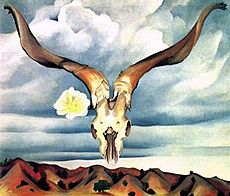
Arthur Dove used many different materials, sometimes in unusual ways, to create his abstract and abstract landscape paintings. Me and the Moon from 1937 is a great example of his abstract landscapes. It's considered one of his most important works. Dove also experimented with collage in the 1920s and mixed his own oil or tempera paints with wax.
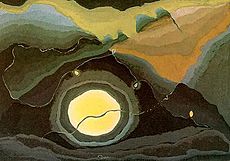
African-American painter Aaron Douglas (1899–1979) is one of the most famous and influential African-American modernist painters. His work greatly helped develop an art style linked to African-American heritage and culture. Douglas was especially important during the Harlem Renaissance.
One of Douglas's most famous paintings is The Crucifixion. It shows clear lines, changes in shadows and light, stylized human bodies, and geometric shapes. The painting's theme reminds viewers of both the biblical story and African-American religious traditions. Other important African-American modernist painters include Beauford Delaney, Charles Alston, Jacob Lawrence, and Romare Bearden. They inspired many artists who came after them.
Modernist Photography
At the start of American modernism, photography was still fighting to be seen as a true art form. Photographer Alfred Stieglitz helped change this. He founded the Photo-Secession group in 1902 with artists like Edward Steichen. Their goal was to improve and promote art photography.
At first, their style was pictorialist. This meant they changed photos using soft focus or special printing to make them look like paintings. Stieglitz also started the magazine Camera Work and ran several galleries, including "291." This gallery became a meeting place for artists and writers. It was also the first place in the U.S. to show early modernist art from European artists like Henri Matisse and Pablo Picasso.
Another important link to European art was Man Ray. Born in America, he was inspired by Stieglitz's galleries. Ray moved to Paris in 1921 and, with artists from the European Dada and Surrealist movements, created new photo techniques like rayographs (placing objects directly on special paper).
In the early 1920s, photographers moved towards straight photography. This style rejected any manipulation of the photo. They wanted to use the camera to capture reality as objectively as possible. They moved away from traditional portraits and pictorial styles. Instead, they used photos to show the tough realities of everyday life, while also finding beauty in details or overall structure. Machines, factories, skyscrapers, and new technology became popular subjects.
In 1932, younger photographers like Ansel Adams and Edward Weston formed Group f/64. This group followed the ideas of straight photography and became a very progressive art group of its time.
American Modernist Literature
American modernist literature was a major style in American writing between World War I and World War II. This era brought new ideas in how poetry and prose were written. It also dealt with many current topics like race, gender, and the human experience. Many American modernists, like T. S. Eliot and Ezra Pound, moved to Europe during this time. They became important figures in the European modernist movement and were often called the Lost Generation.
As a response, many American writers started a trend called 'nativism'. They wanted to show the modern American experience right here in America. Writers like William Carlos Williams and Wallace Stevens were key to this trend. They often criticized the writers who moved to Europe.
World War I deeply influenced many American modernist writers. They explored the emotional and mental wounds left by the war. The economic crisis of the Great Depression in the 1930s also affected literature, seen in books like John Steinbeck's The Grapes of Wrath.
Another important theme was the feeling of being lost and the need to define oneself. Workers often felt like unnoticed parts of a big city machine. American modernists echoed the 19th-century idea of trying to "build a self," a theme shown in Fitzgerald's The Great Gatsby. Madness was also a common modernist theme, appearing in works like Eugene O'Neill's The Emperor Jones. Despite these negative aspects, these themes often led to new hopes and a search for a fresh start.
Modernist literature also allowed for regional styles to develop. This included the Harlem Renaissance and southern modernism. The Harlem Renaissance was a rebirth for African American arts, centered in Harlem, New York. Writers like Langston Hughes and Zora Neale Hurston were key figures. This movement was linked to a growing interest in African American culture, like Jazz music. Many writers used modernist techniques to show African American life, such as using Jazz rhythms and African American dialects in their writing. Southern modernism similarly showed life in the South using modernist styles, with famous writers like William Faulkner.
New Criticism in America
From the 1930s to the 1960s, a powerful way of analyzing literature called New Criticism became very important in the United States. Key figures included John Crowe Ransom and Cleanth Brooks. This method focused on carefully reading and understanding poetry. It taught students to look closely at the words and structure of a poem to find its meaning.
Works by poets like T. S. Eliot and W. B. Yeats were often studied using New Criticism. Eliot's essay "Tradition and the Individual Talent" was very influential. He introduced ideas like "objective correlative" (a set of objects or events that evoke a specific emotion). His work greatly influenced New Criticism in America.
Architecture and Space
The United States played a big role in the modernism movement when it came to new building technologies. New materials like iron, steel, and reinforced concrete were used. The Brooklyn Bridge (1869–1883) by John and Washington Roebling is an early example of using these materials.
Louis Sullivan led the Chicago school of architecture. This group was known for developing functional designs using modern materials. Sullivan's student, Frank Lloyd Wright, learned from him and developed his own unique style called the "prairie style" before World War I. This style featured open floor plans, horizontal lines, and wide, sheltering roofs. His famous works include the Robie House in Chicago (1909) and the Guggenheim Museum in New York City (1946–59).
Wright's buildings often felt connected to nature, using rough stone and wood. His houses aimed to create a feeling of warmth and protection.
Architects from other countries, like Richard Neutra and Rudolf Schindler, also played a big part in American architecture in the 1920s. They developed a style called the international style. This style was seen in corporate office buildings after World War II, such as the Lever House (1952) and the Seagram Building (1956–58) in New York City. When famous European architects like Walter Gropius moved to the U.S., many American architecture schools were influenced by the traditions of the Bauhaus in Germany.
Images for kids
-
Morgan Russell, Cosmic Synchromy (1913–14), Synchromism. Oil on canvas, 41.28 cm × 33.34 cm., Munson-Williams-Proctor Arts Institute.
-
Andrew Dasburg, Improvisation, c. 1915–1916
-
Charles Demuth, Spring, 1921
-
Stuart Davis, Lucky Strike, 1921
-
Charles Demuth, Figure 5 in Gold, 1928


